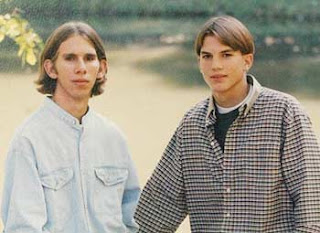 |
| The Kutcher Twins, Michael and Ashton (Tom Vickers/Splash News) |
One role that might not come to mind, however, is the one Kutcher was born into: that of a twin brother.
Ashton's fraternal twin, Michael, currently lives in their home-state Iowa raising his 7-year-old son and selling retirement plans. Diagnosed with cerebral palsy from a young age, Michael's life has been a bit more difficult than his brother's.
"I was the kid with the big Coke-bottle glasses, the hearing aid," Michael Kutcher told Details magazine in 2008. "There was a lot of teasing, a lot of the normal mean stuff."
Although known for pulling elaborate, embarrassing practical jokes on celebrities, Ashton protected his twin against the bullying of other kids. Michael said he was a model brother in many ways, including seeing Michael through a heart transplant at age 13. Having suffered for some time from a heart muscle disease, one day, Michael's heart stopped.
"Ashton never left my side," Michael told People of his brother's devotion through the procedure. "He showed me the love one brother has for another."
One successful heart surgery and twenty years later, Michael isn't looking to replicate Ashton's fame. He has, however, tiptoed into the spotlight as a lobbyist for Reaching for the Stars, an organization that works on behalf of children with cerebral palsy.
"Being Ashton Kutcher's brother, it gives me the opportunity to be that voice, and I realize that I needed to use the opportunity to help others," he explained during his first trip to Washington, D.C. last year.